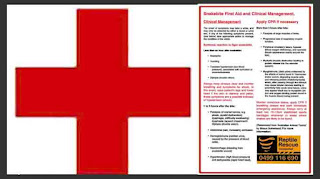Systemic reaction to tiger snakebite.
Less than an hour after snakebite:
• Headache
• Vomiting
• Transient hypotension (low blood pressure), associated with confusion or unconsciousness
• Diplopia (double vision).
Keep airways clear and monitor breathing. Monitor for shock. In the event, raise patient’s legs and lower head if the skin is clammy and pallor, these symptoms are a possible indicator of hypotension (shock).
1 to 3 hours after the bite:
• Paralysis of cranial nerves, e.g. ptosis, (eyelid dysfunction) dysphagia, (difficulty swallowing) dysphasia (speech impairment) diplopia (double vision).
• Abdominal pain, increasing confusion.
• Hemoglobinuria (reddish urine, caused by the presence of blood cells).
• Haemorrhage (bleeding from snakebite wound).
• Hypertension (high blood pressure) and tachycardia (rapid heart beat).
Apply CPR if necessary.
More than 3 hours after bite:
• Paralysis of large muscles of limbs.
• Progressive loss of respiratory muscle function.
• Peripheral circulatory failure, hypoxia (blood oxygen deficiency), and cyanosis (bluish appearance mainly around the lips).
• Myolysis (muscle destruction leading to protein release into the circulatory system).
• Myoglobinuria, (dark urine) evidenced by the effects of toxins found in Tasmanian snake venom, degrading muscle cells and releasing protein (rhabdomyolysis) which, after passing through the kidneys may cause tubular necrosis leading to potentially fatal acute renal failure. Urine may appear black due to myoglobin (an iron- and oxygen-binding protein found in the muscle tissue) being present.
Monitor conscious status, apply CPR if breathing ceases and seek immediate emergency assistance.
Always carry at least two 10 –12cm elasticised sports bandages whenever in areas where snakes are likely to be found.
(Referenced from ‘Australian Animal Toxins’ by Straun Sutherland) For more information:
go to http://reptilerescueaustralia.blogspot.com/






